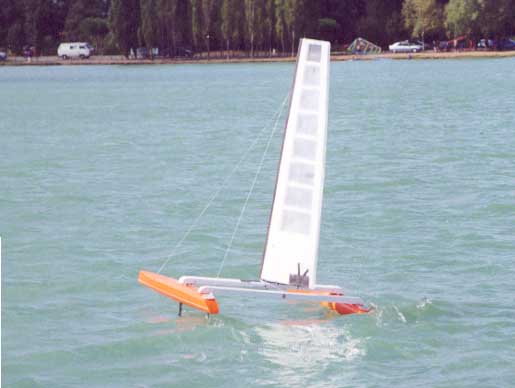I thought that I would provide some details of a very simple wing sail that I have made for a small trimaran (initially mentioned in another thread “Testing a small trimaran”). I haven’t come across this method in my searches, but it is so simple that I can’t imagine that it hasn’t been used before, so my apologies if I am repeating work previously described others. I should begin by saying that it isn’t a high performance wing sail, and may not be particularly durable. However, it only cost me ca. $40 AUD in materials and took ca. 4 hours to make. Therefore it might be an interesting option for those who are curious about wing sails, but don’t want to spend the time and money required to produce a high performance one. I should also state that the technique probably isn’t suitable for large boats. Of the trimaran classes it may only be suitable for the 65M class (I guess that my boat fits in this class being 400 mm in length).
I won’t give detailed instructions or plans, partly because the design isn’t optimised, and partly because the technique is so simple. I’ll just point to the crucial features of the design and construction.
To begin with, the main wing. The construction method is based on a method used to produce simple depron foam model planes using 3mm and 6mm depron foam sheet. A description of the method is provided on the following site:
http://www.depronfoam.co.uk/html/_build_a_wing.html
The only significant differences in my approach was that I:
- used double (5mm width) and single (1mm and 40 mm width) sided tapes rather than glue;
- used a 6mm o.d. carbon fiber tube rather than the spruce spar on the leading edge of the wing (with a few cm protruding from above and below the wing);
- made the wing with one internal 6mm foam piece, cut in a shape that made 3 sections.
- used 6 separate pieces of 3 mmm depron sheet, 2 for each section.
The 3 flaps are made from single layers of 6 mm depron foam sanded into wing shaped profiles.
The flaps are attached to the main wing in the following manner. At the top and bottom of each of the 3 sections of the main wing a piece of teflon tube (3 mm o.d., 1.5 mm i.d.) is taped to the trailing edge (with a small spacer, I used a piece of the 3mm foam, to provide a small gap between the main wing and the flap). On the leading edge of each of the flaps, two pieces of CF tube (3 mm o.d., 1.5 mm i.d.) are taped in such a position that they are immediately above the teflon tube on the wing when the flap is in the correct position. The wing and flaps are then attached by passing a length of carbon rod (1 mm o.d.) through the tubes on the main wing and flaps. Each of the flaps are joined by a piece of tape on each side.
The CF tube on the leading edge of the main wing has another CF tube (3 mm o.d.) threaded through it. This thinner tube is positioned in a hole on the deck, and at the top it is attached to the stays that hold the whole assembly in place. The wing sail rotates around this inner thinner tube.
A couple of pieces of carbon tube are attached to the lower edges of the main wing and flaps as attachment points for the sheeting system cords. The approach to control of the main wing and flaps is shown below:
Due to the size of my boat each cord is controlled by the same sail winch and consequently it is not possible to adjust the position of the flaps relative to the main wing (except during the setup). In a larger boat it would be possible to add another servo, and thus be able to control the flaps independently. Despite this, the boat seems to sail ok, but did take a bit of experimentation to determine the lengths for the two cords that provides reasonable angles between the main wing and flaps over a range of main wing settings.
By adding a third lead off the continuous loop, a jib can also be controlled.
Some details of the completed structure:
Height: 540 mm
Width: 160 mm (max)
Final weight: 70 g
Some footage of the sail in action:
[video=youtube_share;_e7S-Z9NRRw]http://youtu.be/_e7S-Z9NRRw[/video]
It is certainly different to sailing with a conventional sail, providing alot more power for a similar surface area. Too much power in this case, my next sail will be a bit smaller.
Now for a disclaimer: Everything I know about wing sails I’ve learnt in the last week. It is therefore very likely that I have made numerous errors in the design. Any tips, comments and refinements would be appreciated.




